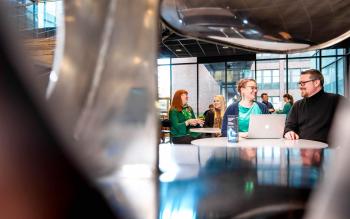Lead paragraph
There is something constant about education, something permanent. Education has always been linked to surrounding society and its changing needs.
Educational institutions have been established because society has needed new experts. They have also been closed down because certain kinds of skills have no longer been needed.
Our story starts in the late 19th century. The following educational institutions are all part of Haaga-Helia’s past:
- Privat Handelsläroverket i Helsingfors (1881)
- Suomen liikemiesten kauppaopisto (1898)
- Porvoon naisopisto (1912)
- Suomen urheiluopisto (1927)
- Tehtaitten Koulu Oy (1944)
- Malmin kauppaopisto (1957)
- Porvoon kauppaoppilaitos (1958)
- Helsingin Sihteeriopisto (1967)
- Hotelli- ja ravintolaopisto (1969)
- ATK-instituutti (1972)
- Porvoon matkailualan oppilaitos (197?)
First university of applied sciences in Finland
The Finnish system of universities of applied sciences was created in the 1990s. The first licence was granted to Haaga Instituutti University of Applied Sciences founded in 1991. The following year, Helia University of Business and Applied Sciences was also granted a licence to operate. During the depression of the 1990s, people wanted to believe in a better future and the opportunities high-quality education could provide.
In 1993, Haaga Instituutti launched the first English-taught UAS degree programme in Finland (Degree Programme in Hospitality Management).
The next significant change took place in 2007 when these two universities of applied sciences merged, and Haaga-Helia University of Applied Sciences was established.
Changing shape, constant core
Here at Haaga-Helia, we look at our past with pride whilst remembering that education always looks into the future. Education responds to topical needs – in fact, it very much anticipates the future needs of society. That is the basis of its vigour and energy.
Today's Haaga-Helia promises to open doors to working life. This same promise was given when the first educational institutions which are part of Haaga-Helia’s past were founded.
Our story is filled with many people, plenty of courage and a pioneering outlook. These things are also part of our constant core. We create new working life.
VOCATIONAL TEACHER EDUCATION SINCE 1950
In 1997, teacher training provided by the Business College Helsinki was transferred to the School of Vocational Teacher Education that had been established as part of Helia University of Applied Sciences. Teacher training was expanded, and the School of Vocational Teacher Education started training teachers for all vocational educations sectors.
Since 2006, the School of Vocational Teacher Education has included a programme for special education teachers and since 2011, for guidance counsellors as well. Haaga-Helia University of Applied Sciences was established in 2007, and the School of Vocational Teacher Education continued operating in connection to it.
Education preparing students for a profession and working life has over a century old history in Finland. At first, the development of vocational education of different sectors was administratively scattered within different ministries. There was no systematic teacher training. Teaching staff consisted of individuals who had, depending on the sector or duties, obtained a university degree or primary school teacher training qualification or who were professionals with working life experience.
Establishing teacher training for vocational education received wide political support. Thus, the Ministry of Trade and Industry took a positive outlook on the Business College Helsinki’s application to implement teacher training. A decision dated 17 October 1950 states that the ministry ”considers it beneficial to assign the Business College Helsinki the right to operate as a business college in which those aiming to become business teachers can undertake teacher training and practical teaching exams in accordance with the above-mentioned decree and the decision of the ministry.”
Text: Jari Laukia

